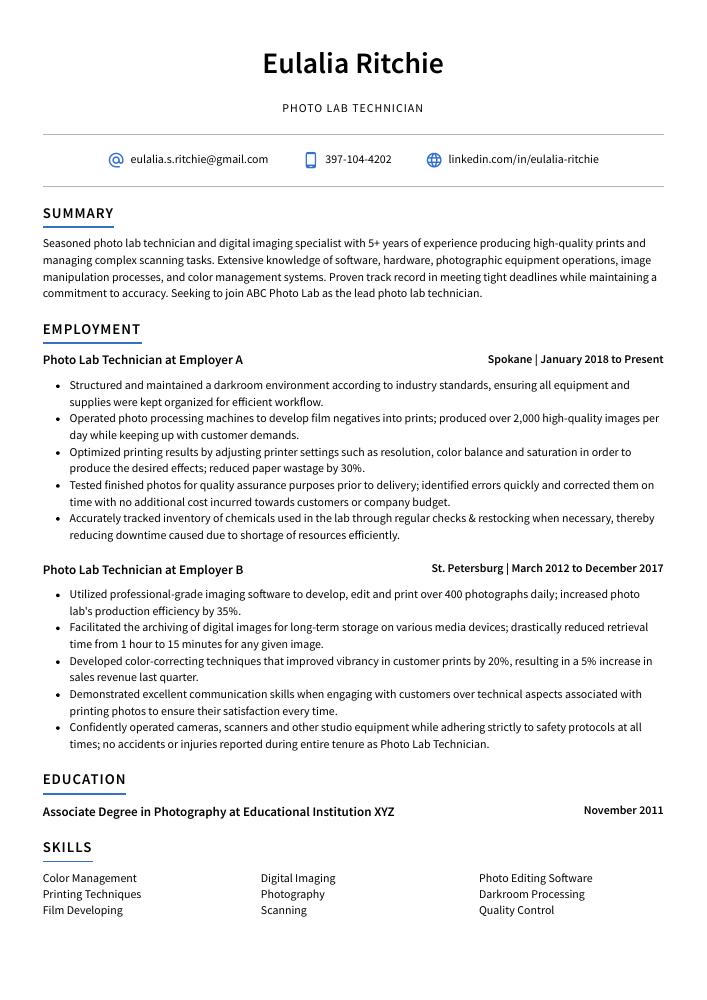Photo Lab Technician Resume Guide
Photo lab technicians process and print photographs, develop film, and repair photographic equipment. They also help customers with inquiries about products or services offered at the photo lab.
You’re a master of the darkroom, and you know all there is to know about processing film. But employers haven’t seen your expertise yet; make sure they do by writing a resume that captures their attention.
This guide will walk you through the entire process of creating a top-notch resume. We first show you a complete example and then break down what each resume section should look like.
Table of Contents
The guide is divided into sections for your convenience. You can read it from beginning to end or use the table of contents below to jump to a specific part.
Photo Lab Technician Resume Sample
Eulalia Ritchie
Photo Lab Technician
[email protected]
397-104-4202
linkedin.com/in/eulalia-ritchie
Summary
Seasoned photo lab technician and digital imaging specialist with 5+ years of experience producing high-quality prints and managing complex scanning tasks. Extensive knowledge of software, hardware, photographic equipment operations, image manipulation processes, and color management systems. Proven track record in meeting tight deadlines while maintaining a commitment to accuracy. Seeking to join ABC Photo Lab as the lead photo lab technician.
Experience
Photo Lab Technician, Employer A
Spokane, Jan 2018 – Present
- Structured and maintained a darkroom environment according to industry standards, ensuring all equipment and supplies were kept organized for efficient workflow.
- Operated photo processing machines to develop film negatives into prints; produced over 2,000 high-quality images per day while keeping up with customer demands.
- Optimized printing results by adjusting printer settings such as resolution, color balance and saturation in order to produce the desired effects; reduced paper wastage by 30%.
- Tested finished photos for quality assurance purposes prior to delivery; identified errors quickly and corrected them on time with no additional cost incurred towards customers or company budget.
- Accurately tracked inventory of chemicals used in the lab through regular checks & restocking when necessary, thereby reducing downtime caused due to shortage of resources efficiently.
Photo Lab Technician, Employer B
St. Petersburg, Mar 2012 – Dec 2017
- Utilized professional-grade imaging software to develop, edit and print over 400 photographs daily; increased photo lab’s production efficiency by 35%.
- Facilitated the archiving of digital images for long-term storage on various media devices; drastically reduced retrieval time from 1 hour to 15 minutes for any given image.
- Developed color-correcting techniques that improved vibrancy in customer prints by 20%, resulting in a 5% increase in sales revenue last quarter.
- Demonstrated excellent communication skills when engaging with customers over technical aspects associated with printing photos to ensure their satisfaction every time.
- Confidently operated cameras, scanners and other studio equipment while adhering strictly to safety protocols at all times; no accidents or injuries reported during entire tenure as Photo Lab Technician.
Skills
- Color Management
- Digital Imaging
- Photo Editing Software
- Printing Techniques
- Photography
- Darkroom Processing
- Film Developing
- Scanning
- Quality Control
Education
Associate Degree in Photography
Educational Institution XYZ
Nov 2011
Certifications
Certified Photographic Technician
Professional Photographic Certification Commission
May 2017
1. Summary / Objective
Your resume summary should provide the hiring manager with a snapshot of your experience and qualifications as a photo lab technician. In this section, you can highlight your knowledge in digital photography, any awards or certifications you have received for excellence in the field, and how many years of experience you have working with different types of cameras. Additionally, mention any customer service skills that make you an ideal candidate for the job.
Below are some resume summary examples:
Amicable and experienced photo lab technician with 5+ years of experience in developing, printing and scanning photographs. At XYZ Photo Lab developed a system that reduced the time taken to produce prints by 25%. Also created an online platform for customers to order prints and pick them up at their convenience. Passionate about helping photographers achieve great results with their work through quality digital imaging services.
Detail-oriented photo lab technician with 8+ years of experience in developing and printing photographs. Skilled at using a variety of digital photography tools, including Adobe Photoshop and Lightroom, to ensure quality results. At XYZ Labs demonstrated excellent customer service skills while working on over 500 orders daily. Received ‘Employee of the Year’ award for outstanding performance in 2019-2020 fiscal year.
Reliable photo lab technician with over 10 years of experience developing and printing high-quality photos for commercial, amateur, and professional photographers. Skilled in using a wide range of digital imaging software packages to restore old photographs and adjust color tones. Looking to join ABC Photo Lab as the primary photo lab technician where I can use my expertise to ensure accurate processes are followed.
Determined photo lab technician with 5+ years of experience processing digital and film-based photographs for a variety of clients. Responsible for developing prints, scanning photos into computers, and performing minor touch-ups to ensure quality standards are met. Looking to join ABC Imaging as the next Photo Lab Technician where I can use my expertise in photography to create stunning visuals for customers.
Proficient photo lab technician with 10+ years of experience developing and printing photographs for professional photographers. At XYZ, managed the daily operations of a busy photo lab including processing orders, maintaining equipment, and troubleshooting technical issues. Recognized as an efficient problem-solver who consistently produces high-quality results in fast turnaround times.
Committed photo lab technician with 3+ years of experience developing and printing photos for clients. Skilled in using photo-editing software, lighting equipment, and working with a variety of cameras to create the highest quality prints possible. Seeking to join ABC Photo Lab where I can use my skillset to produce stunning pictures that will exceed customer expectations.
Skilled photo lab technician with 5+ years of experience developing and printing photos for both amateur and professional photographers. Proficient in the use of digital imaging systems, editing software, darkroom equipment, and a variety of photo-processing techniques. Looking to join ABC Photo Lab as a technician to help produce high-quality prints for their customers.
Diligent and experienced photo lab technician with 5+ years of experience in creating high-quality prints for clients. At XYZ, developed a customer loyalty program that increased revenue by 10%. Also responsible for the daily maintenance and upkeep of all equipment used to create prints. Proficient in Adobe Creative Suite programs and Photoshop editing software.
2. Experience / Employment
The employment (or experience) section is where you talk about your work history. It should be written in reverse chronological order, meaning that the most recent job is listed first.
Stick to bullet points primarily in this section; doing so makes it easier for the reader to take in what you have to say quickly and efficiently. When writing each point, provide detail on what tasks were completed and results achieved. For example, instead of saying “Processed film,” you could say, “Developed 35mm color negatives using a darkroom enlarger with an accuracy rate of 97%.”
To write effective bullet points, begin with a strong verb or adverb. Industry specific verbs to use are:
- Processed
- Developed
- Printed
- Edited
- Scanned
- Retouched
- Calibrated
- Monitored
- Operated
- Inspected
- Assembled
- Adjusted
- Tested
- Troubleshot
- Replaced
Other general verbs you can use are:
- Achieved
- Advised
- Assessed
- Compiled
- Coordinated
- Demonstrated
- Expedited
- Facilitated
- Formulated
- Improved
- Introduced
- Mentored
- Optimized
- Participated
- Prepared
- Presented
- Reduced
- Reorganized
- Represented
- Revised
- Spearheaded
- Streamlined
- Structured
- Utilized
Below are some example bullet points:
- Improved photo quality by calibrating digital printers and scanners, resulting in a 15% reduction of customer complaints about image sharpness.
- Calibrated and maintained all photo processing equipment on a daily basis to ensure that products met the highest standards; upgraded software programs for faster loading time, saving 6 hours per week.
- Substantially increased production efficiency by reorganizing workflows, which reduced processing time from 3 days to 1 day while maintaining accuracy and quality assurance standards throughout the process.
- Represented company at industry events & conferences as an expert photographer; received 20+ positive reviews from attendees citing high technical proficiency with camera settings & lighting techniques used during demonstrations.
- Reorganized inventory systems for easy access to photographic supplies such as paper rolls, films & negative holders, allowing staff members quick retrieval times when needed – reducing downtime by 42%.
- Revised over 200 photos, increasing quality by 40% and ensuring all prints met customer specifications.
- Expedited photo development process from 5 hours to 2 hours per order, helping the lab reduce processing time by 60%.
- Prepared digital photographic images for printing with a high degree of accuracy and detail; reduced errors in preparation processes by 22%.
- Reliably operated various machines such as scanners, printers & enlargers to produce professional-grade photographs within tight deadlines at an affordable cost for customers.
- Adjusted color balance levels according to client needs while developing film negatives into finished prints; improved clarity of pictures produced by 30%.
- Reduced photo lab costs by 25% through prudent management of resources and efficient ordering of materials.
- Introduced innovative methods to improve the speed, accuracy and quality of photo processing; improved turnaround time for orders by 35%.
- Achieved a 98% customer satisfaction rating thanks to consistently high-quality results in prints, enlargements, digital copies & montages.
- Resourcefully troubleshooted machine malfunctions during peak hours with minimal disruption to production workflow; repaired 20+ machines every month on average without outsourcing services.
- Monitored inventory levels closely and placed timely orders for chemicals, papers & other supplies necessary for operations; kept wastage within budget limits at all times.
- Presented photography services to over 100 customers daily, including ordering prints and restoring old photographs; increased sales revenue by an additional $2,500 in the last quarter.
- Compiled a portfolio of high-quality images from customer orders while ensuring that all photos were printed accurately according to exact specifications provided by clients.
- Mentored junior lab technicians on operating digital imaging tools and darkroom equipment such as enlargers and scanners; improved their work output rate by 30%.
- Diligently inspected each photo for any errors or defects before delivery, correcting mistakes identified during post-processing with professional editing software packages like Adobe Photoshop & Lightroom Classic CC within 3 hours on average per order.
- Participated in companywide photography competitions which included developing creative concepts for promotional campaigns and taking photographs at special events; won Best Photojournalism award twice consecutively since 2018.
- Assembled and operated photographic equipment such as cameras, scanners and printers to develop film negatives into high-quality prints; produced over 1,000 prints per week with 98% customer satisfaction.
- Replaced worn parts in darkroom equipment on a regular basis to ensure the production of quality photos without any defects; reduced image distortion by 40%.
- Assessed customers’ needs accurately and recommended suitable products or services accordingly; increased sales revenue by $5,500 within three months through upselling techniques.
- Printed digital images onto canvas or photo paper using specialized software programs while adhering strictly to industry standards for color correction & calibration; decreased print turnaround time by 10 minutes per order on average.
- Independently maintained records of all inventory items including chemicals used for developing photographs and kept track of stock levels at all times for smooth operations in the lab facility.
- Efficiently operated digital, film and analog photo processing equipment; developed over 200+ prints daily with an accuracy rate of 99%.
- Formulated photographic solutions according to customer specifications and processed negatives for printing in both color and black & white.
- Edited images using Adobe Photoshop to enhance their quality by adjusting brightness, contrast, color balance etc., increasing customer satisfaction scores by 10%.
- Retouched photographs as per client requests while ensuring that the final product met all standards of quality before releasing it for printouts; reduced editing time by 15 minutes per photograph on average.
- Scanned transparencies up to 8×10 inches in size utilizing a high-resolution flatbed scanner; increased scanning speed by 25% within 3 months of joining the team due to improved familiarity with equipment operations.
- Spearheaded the development of over 1,500 digital and analog photographs per day with professional-grade cameras/equipment; reduced batch processing time by 25%.
- Inspected each photograph for quality assurance prior to final printing, ensuring that all clients received the highest level of service possible.
- Streamlined workflow processes in order to maximize efficiency and minimize turnaround times on large orders; increased production output by 50% within 6 months.
- Coordinated between photography staffs and photo lab technicians daily to ensure that projects were completed accurately & punctually; improved team collaboration across multiple departments resulting in a 20% increase in productivity per hour spent on tasks related to image editing/printing services.
- Meticulously maintained equipment such as printers, scanners, laminators etc., troubleshooting malfunctions when necessary while keeping repair costs under $150 monthly on average throughout the duration of employment at company XYZ Ltd.
- Troubleshot and resolved a wide range of technical issues in the photo lab, such as malfunctioning printers and software errors; reduced downtime by 25%.
- Competently developed film rolls and processed digital images using specialized equipment with an emphasis on quality assurance; achieved 99% customer satisfaction rate for all orders fulfilled.
- Processed over 1,000 prints per day at peak periods while adhering to strict production timelines; increased overall output efficiency by 10%.
- Advised customers on how to best use the latest technology available when printing photos from their phones or memory cards, resulting in a 20% increase in sales of high-end products.
3. Skills
Skill requirements will differ from employer to employer – this can easily be determined via the job advert. Organization ABC might require experience with digital photography, while Organization XYZ might need someone who is knowledgeable in film processing.
When writing your resume’s skills section, it is important to tailor this part of the document to each job you are applying for. This will help ensure that applicant tracking systems (which many employers use) recognize relevant keywords and pass on your application to a human reviewer.
In addition to listing skills here, you should also discuss them further in other parts of the resume such as the summary or work history sections.
Below is a list of common skills & terms:
- Color Management
- Darkroom Processing
- Digital Imaging
- Film Developing
- Photo Editing Software
- Photography
- Printing Techniques
- Quality Control
- Scanning
4. Education
Including an education section on your resume will depend on how far along you are in your career. If you just graduated and have no prior experience, mention your education below the resume objective. However, if you have been working as a photo lab technician for years with plenty of different duties to showcase, omitting the education section is perfectly fine.
If an education section is included, try to list courses or subjects that are relevant to the photo lab technician role such as photography basics or digital image processing techniques.
Associate Degree in Photography
Educational Institution XYZ
Nov 2011
5. Certifications
Certifications are an important part of your resume as they demonstrate to a potential employer that you have the necessary skills and knowledge for the job. Having certifications in relevant fields can also show that you are actively keeping up with industry trends and staying current on best practices.
Including any certifications related to the position will help make your application stand out from other candidates, so be sure to list them prominently if applicable.
Certified Photographic Technician
Professional Photographic Certification Commission
May 2017
6. Contact Info
Your name should be the first thing a reader sees when viewing your resume, so ensure its positioning is prominent. Your phone number should be written in the most commonly used format in your country/city/state, and your email address should be professional.
You can also choose to include a link to your LinkedIn profile, personal website, or other online platforms relevant to your industry.
Finally, name your resume file appropriately to help hiring managers; for Eulalia Ritchie, this would be Eulalia-Ritchie-resume.pdf or Eulalia-Ritchie-resume.docx.
7. Cover Letter
A cover letter is a document that provides additional information about your qualifications and professional experience. It’s usually made up of 2 to 4 short paragraphs, separate from your resume. Its purpose is to help you explain why you’re the ideal candidate for the job by demonstrating how well suited you are for it.
Cover letters may not be mandatory in most applications but writing one can give hiring managers more insight into who you are and what makes you perfect for the role. Plus, they offer an opportunity to make yourself stand out from other applicants!
Below is an example cover letter:
Dear Rico,
I am interested in applying for the Photo Lab Technician position at your company. As a skilled technician with experience developing and printing photos, I am confident I would make a valuable contribution to your team.
In my current role as Photo Lab Technician at [company name], I develop and print photos for customers using state-of-the-art equipment. I also maintain inventory levels, troubleshoot technical issues, and provide excellent customer service. My attention to detail and commitment to quality have resulted in high levels of customer satisfaction; in fact, I have received numerous compliments on my work from satisfied customers.
I am confident that I can be an asset to your company as a Photo Lab Technician. Please find attached a copy of my resume for your review; if you have any questions, do not hesitate to contact me at [phone number] or [email address]. Thank you for your time and consideration; I look forward to hearing from you soon.
Sincerely,
Eulalia
Photo Lab Technician Resume Templates
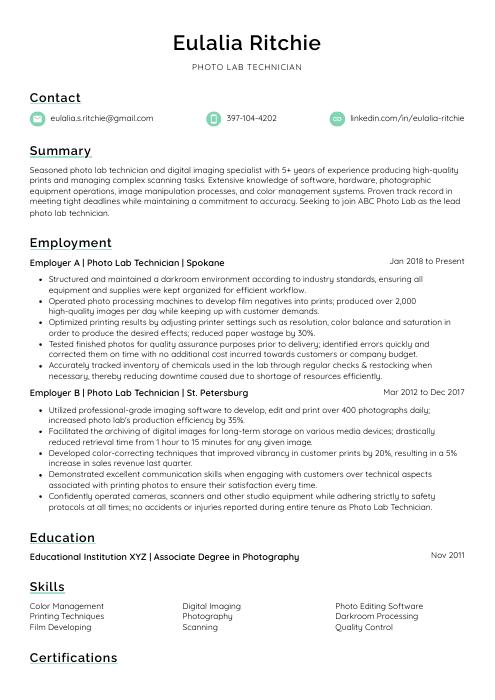 Lorikeet
Lorikeet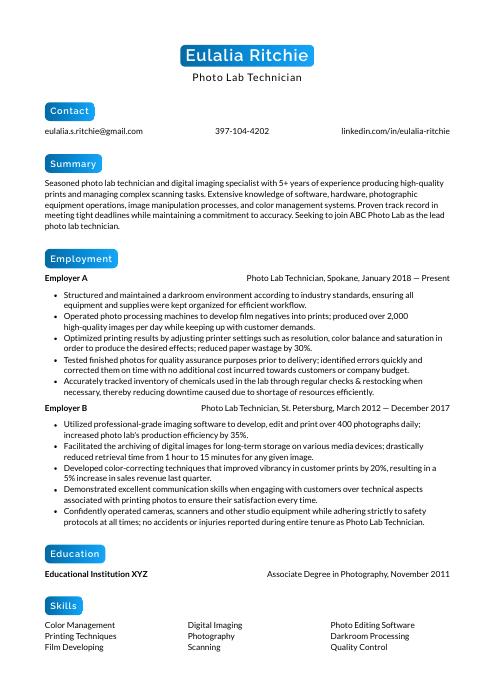 Kinkajou
Kinkajou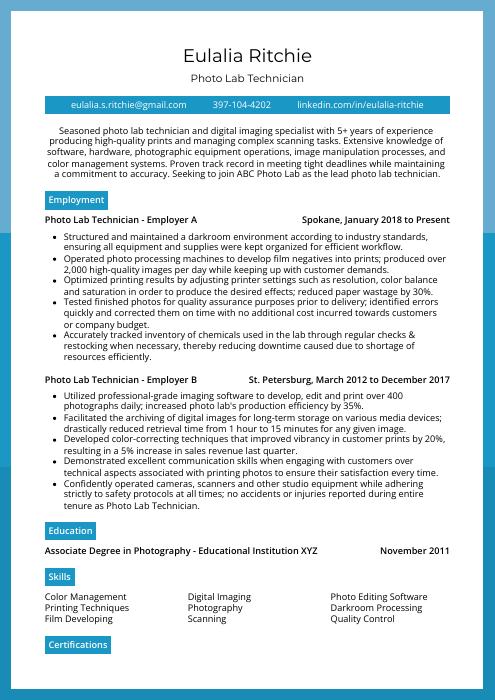 Rhea
Rhea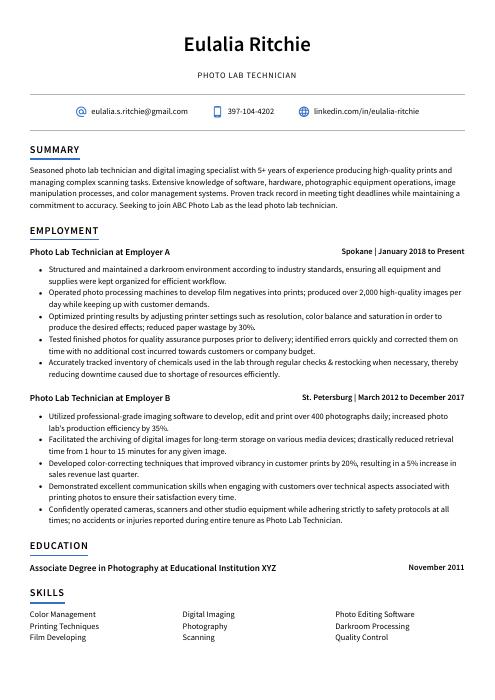 Axolotl
Axolotl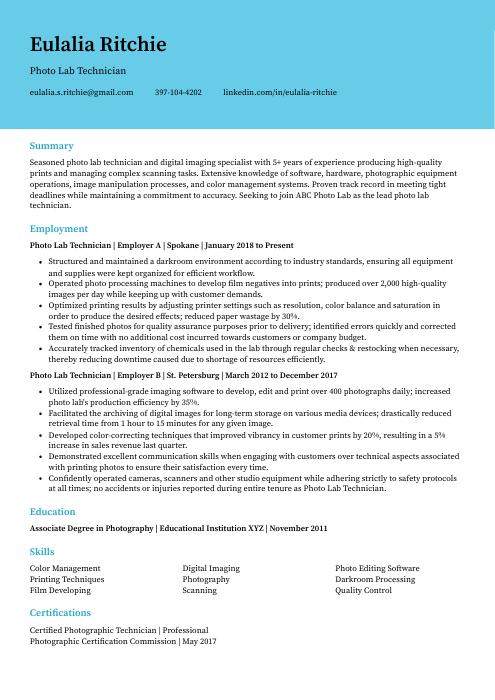 Dugong
Dugong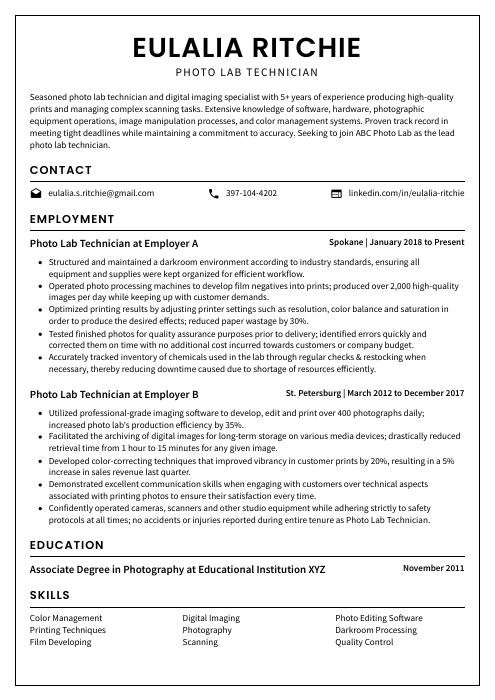 Cormorant
Cormorant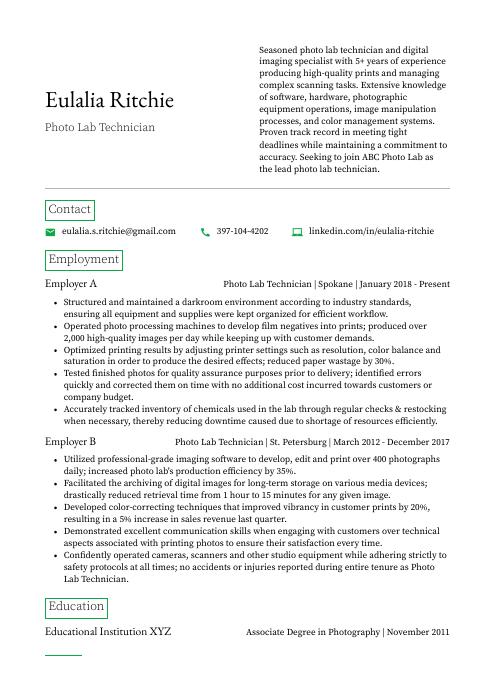 Quokka
Quokka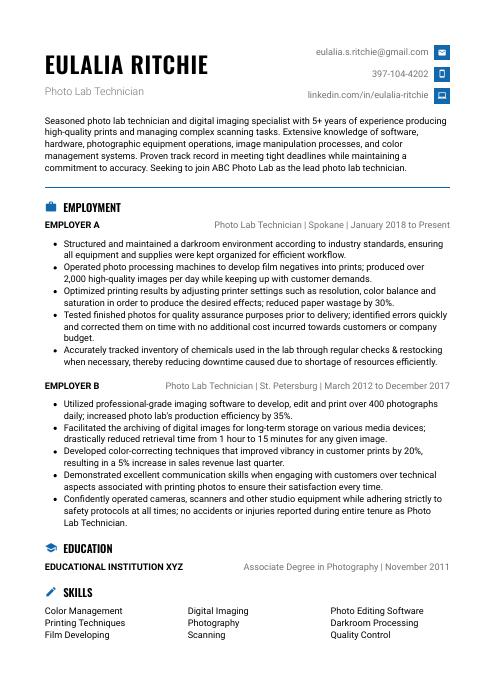 Echidna
Echidna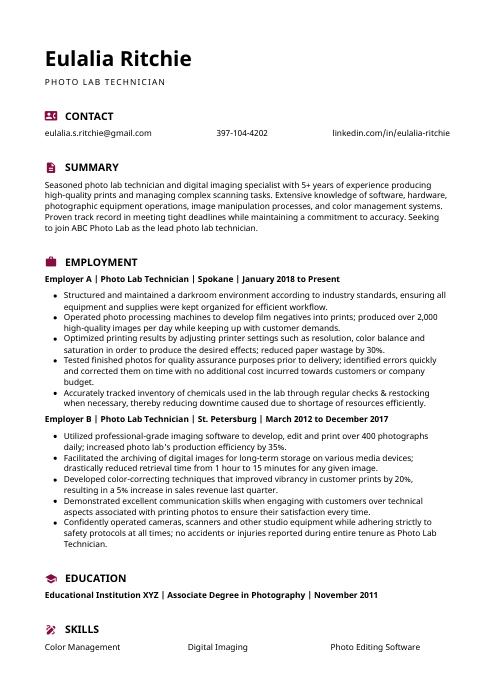 Hoopoe
Hoopoe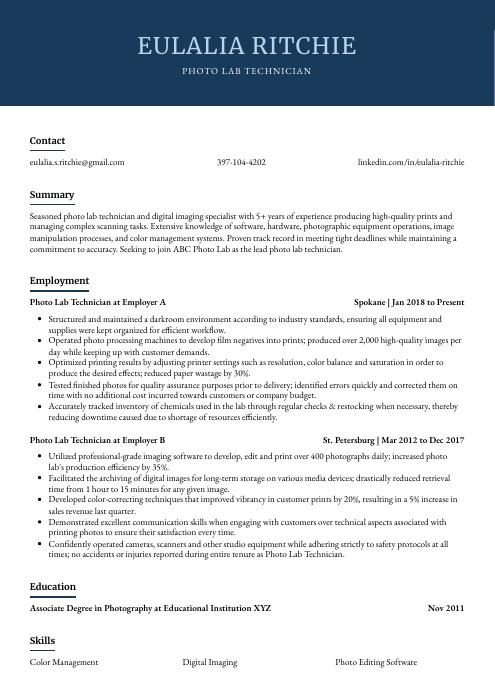 Bonobo
Bonobo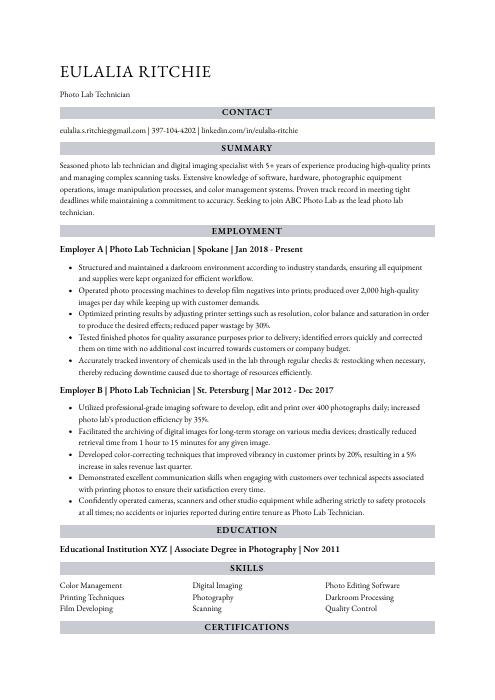 Numbat
Numbat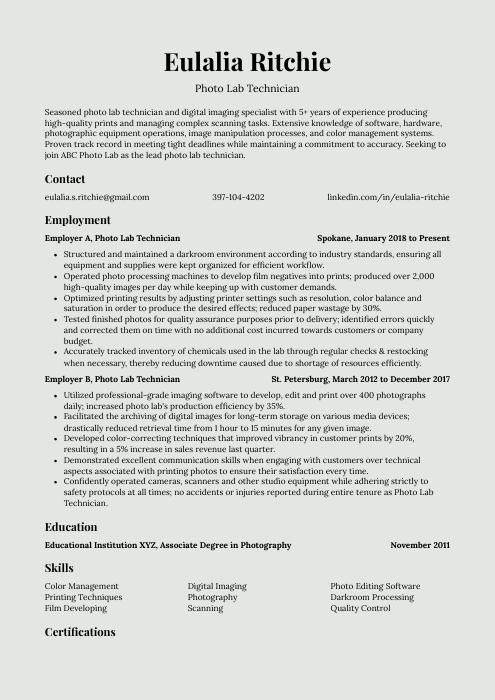 Saola
Saola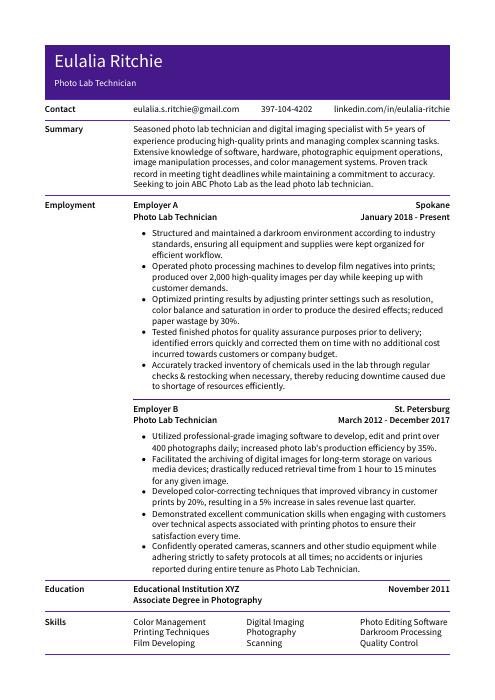 Pika
Pika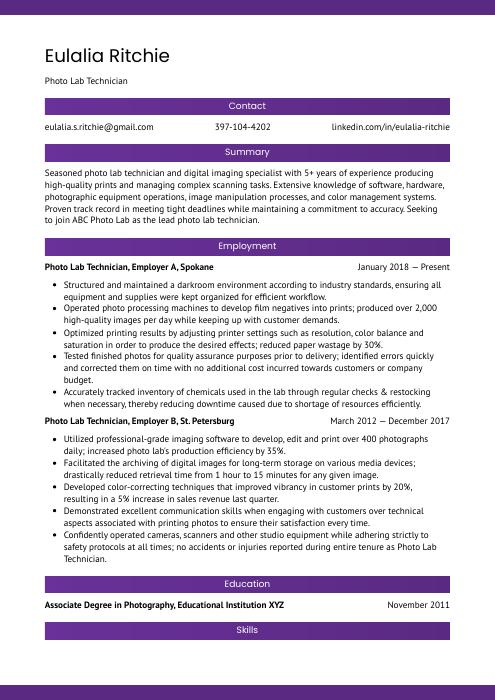 Jerboa
Jerboa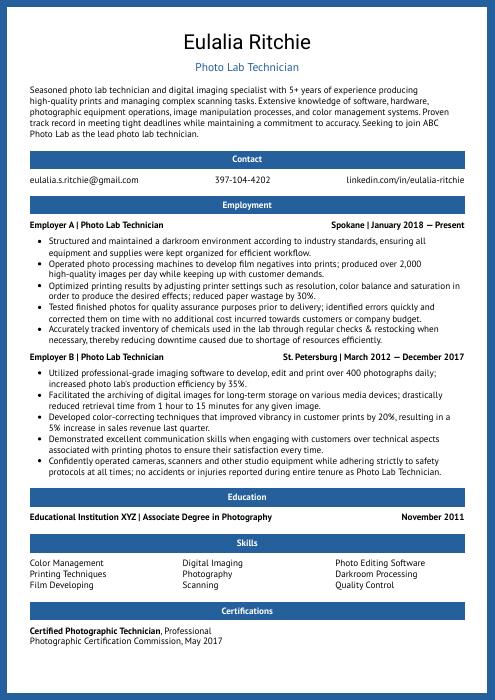 Ocelot
Ocelot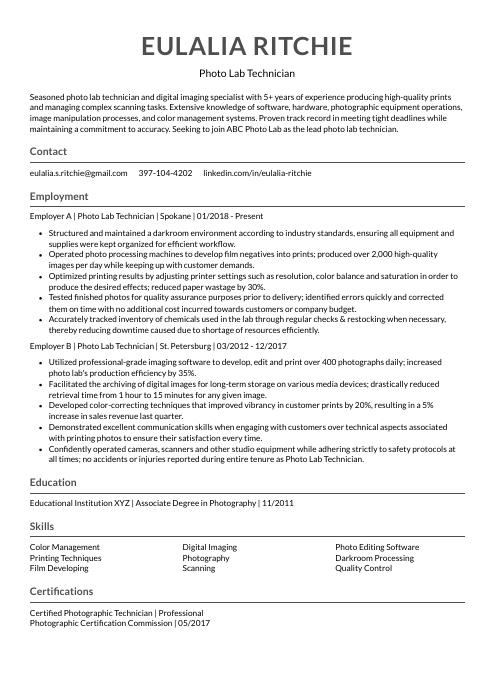 Indri
Indri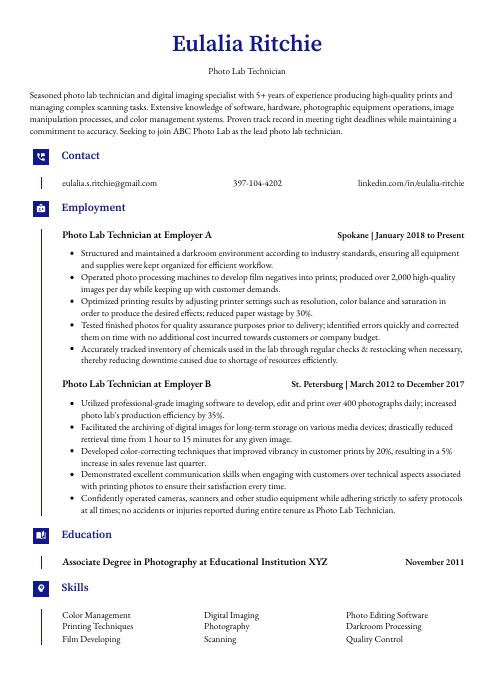 Gharial
Gharial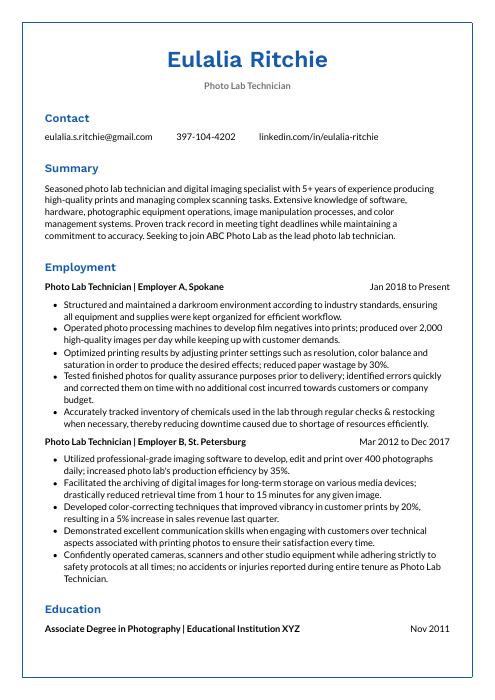 Markhor
Markhor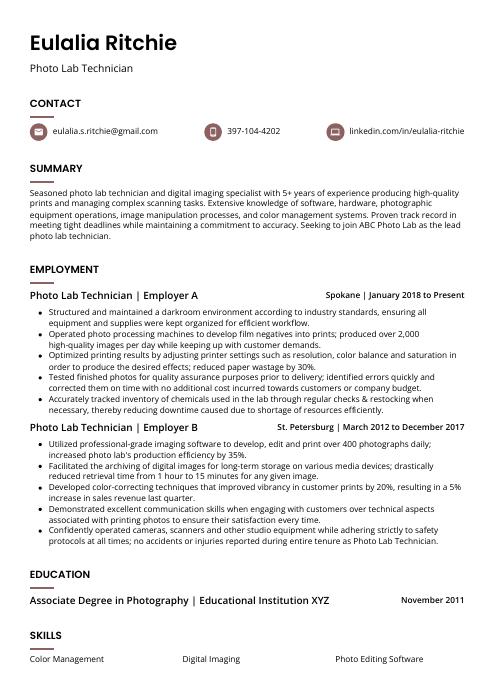 Fossa
Fossa Rezjumei
Rezjumei
